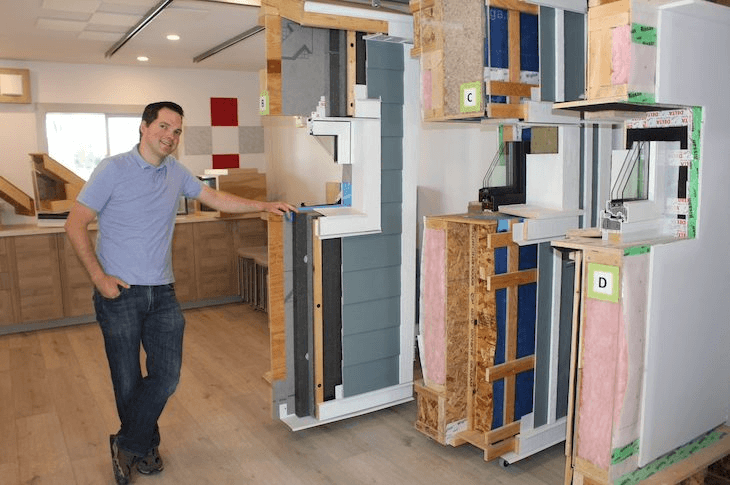How net-zero commitments are creating new jobs: The growing need for high-performance homes
All levels of government have committed to reducing greenhouse gas emissions by 2050. High-performance homes and buildings play a big part in reaching that goal — and it's creating a new demand for energy-savvy construction talent.

Ben Hildebrandt, Principal Investigator, Building and Material Sciences for Green Building Technologies within SAIT’s Applied Research and Innovation Services (ARIS), showcases the wall library used to demonstrate the differences between various building ages and materials.
Net-zero — it’s a term you’ve likely heard on the news or social media. To put it plainly, it's when emissions released into the atmosphere are balanced by emissions taken out.
The Federal government has shared detailed plans to reduce emissions on a national level by 2050, but both provinces and cities are stepping up with their own proposals to help. In July 2022, the City of Calgary approved a strategy to work towards its goal of net-zero emissions by 2050 — and reducing emissions created by homes and buildings is a big part of the plan.
According to the Calgary Climate Strategy: Pathways to 2050 (June 2022, City of Calgary), Natural gas and electricity used in residential, commercial, institutional and industrial buildings make up about two-thirds of total emissions generated in our city. The same report shows approximately 50% of the buildings standing in Calgary today will still be in use in 2050 — meaning ambitious and widespread building retrofits need to occur.
This strategy identifies homes and buildings as a critical area to reduce emissions, meaning new homes will be held to new standards and old ones will need to be updated.
To action this ambitious plan, the industry needs new talent equipped with the latest knowledge in high-performance building. That’s where Continuing Education’s High-Performance Residential Design and Construction (HPRDC) certificate comes in.
The five courses that make up the certificate were developed by SAIT’s Green Building Technologies team within Applied Research and Innovation Services (ARIS), sparked by a generous donation from Alberta Innovates.
“At the end of 2018, we sent a proposal to Alberta Innovates and obtained funding to develop curriculum and increase our testing and analysis capabilities to help builders get from what they are building today — to building net-zero. For buildings, net-zero most often refers to producing as much energy as they consume over the course of the year.” says Ben Hildebrandt, Principal Investigator, Building and Material Sciences for Green Building Technologies within ARIS.
“The City of Calgary pathway to 2050 is clearly establishing a need for this education as well,” he adds.
Hildebrandt played a key role in developing the certificate and brings years of industry experience to the table.
“We started off with a lot of outreach to the industry and we did focus groups with nearly 40 professionals from the Alberta residential construction industry,” explains Hildebrandt. “After the consultations, our course outlines changed 40 to 50 percent, so we’ve designed these courses based on what the industry said they need.”
The certificate is aimed at existing professionals in the construction industry, including architects, engineers, technologists, site supervisors, contractors, labourers, or anyone who has a base knowledge of construction. It’s also a great fit for those already in SAIT’s architecture, civil technologies or construction project management programs.
“A learner can go from getting a certificate of completion — whether they’re a designer for an architecture firm, a technologist doing custom designs, a large home builder, or someone on site — and apply the knowledge to their job as soon as they’re done,” says Hildebrandt.
The flexible online delivery is designed to give students the freedom to work full-time while earning an in-demand certificate. Each course also offers a chance to earn a micro-credential, which is a verified badge that can be shared on LinkedIn if you achieve a high grade. SAIT’s Corporate Training can also easily cater the programming to train an entire team at once.
As for the future, SAIT hears the demand for retrofit training — loud and clear — and students can expect new offerings coming in 2023.
“We’re building more courses since receiving funding from the Smart Sustainable Resilient Infrastructure Association. We’re working on a retrofit course, where we further explore how to retrofit existing homes to make them higher performance.”
As Calgary continues to employ strategies in its Climate Strategy: Pathways to 2050, there’s never been a better time to learn high-performance building techniques as the demand for this knowledge continues to grow.
Registration for the HPRDC certificate program offered through SAIT’s Continuing Education and Professional Studies is now open.

Oki, Âba wathtech, Danit'ada, Tawnshi, Hello.
SAIT is located on the traditional territories of the Niitsitapi (Blackfoot) and the people of Treaty 7 which includes the Siksika, the Piikani, the Kainai, the Tsuut’ina and the Îyârhe Nakoda of Bearspaw, Chiniki and Goodstoney.
We are situated in an area the Blackfoot tribes traditionally called Moh’kinsstis, where the Bow River meets the Elbow River. We now call it the city of Calgary, which is also home to the Métis Nation of Alberta.